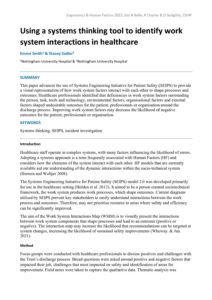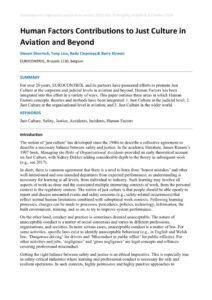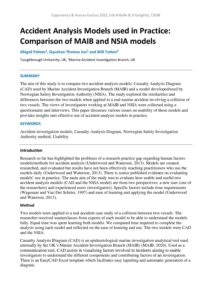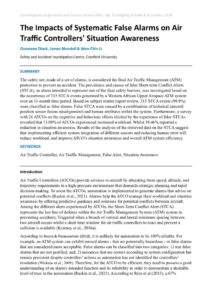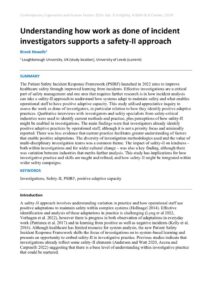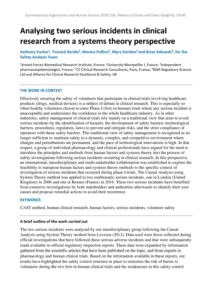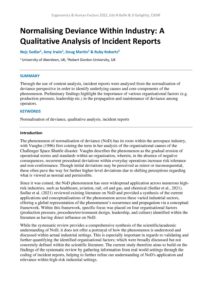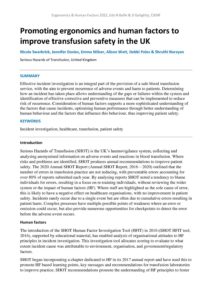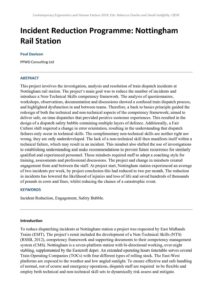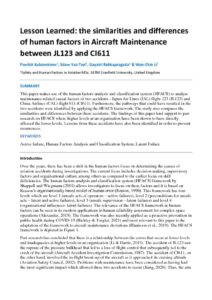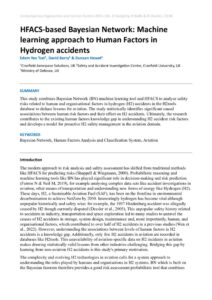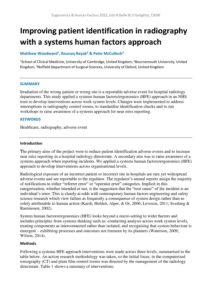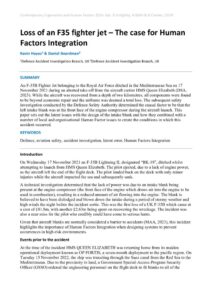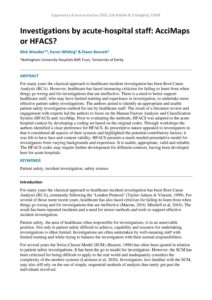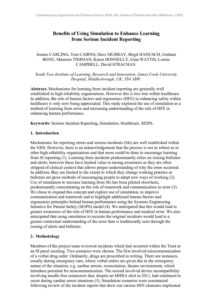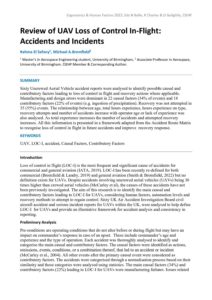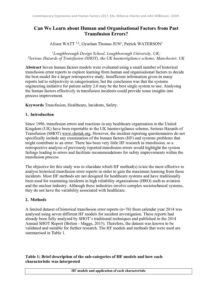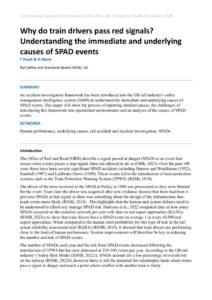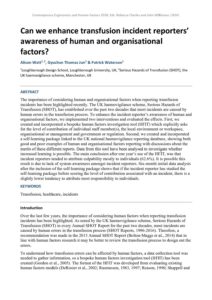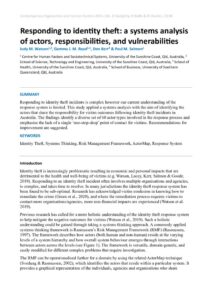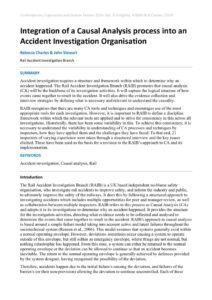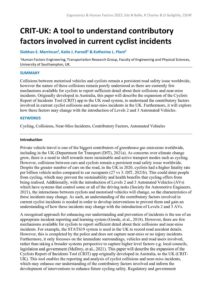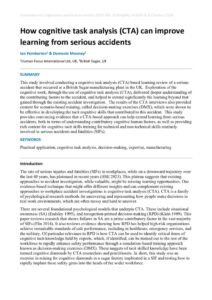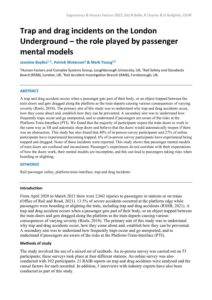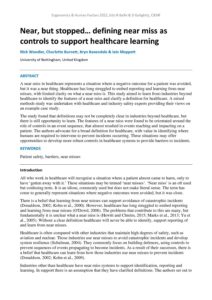Incidents
Using a systems thinking tool to identify work system interactions in healthcare
| Document | Author Emma Smith & Stacey Sadler |
| Abstract This paper advances the use of Systems Engineering Initiative for Patient Safety (SEIPS) to provide a visual representation of how work system factors interact with each other to shape processes and outcomes. Healthcare professionals identified that deficiencies in work system factors surrounding the person, task, tools and technology, environmental factors, organisational factors and external factors shaped undesirable outcomes for the patient, professionals or organisation around the discharge process. Improving work system factors may decrease the likelihood of negative outcomes for the patient, professionals or organisation. |
Human Factors Contributions to Just Culture in Aviation and Beyond
| Document | Author Steven Shorrock, Tony Licu, Radu Cioponea & Barry Kirwan |
| Abstract For over 20 years, EUROCONTROL and its partners have pioneered efforts to promote Just Culture at the corporate and judicial levels in aviation and beyond. Human Factors has been integrated into this effort in a variety of ways. This paper outlines three areas in which Human Factors concepts, theories and methods have been integrated: 1. Just Culture at the judicial level; 2. Just Culture at the organisational level in aviation; and 3. Just Culture in the wider world. |
Accident Analysis Models used in Practice: Comparison of MAIB and NSIA models
| Document | Author Abigail Palmer, Gyuchan Thomas Jun & Will Tutton |
| Abstract The aim of this study is to compare two accident analysis models: Casualty Analysis Diagram (CAD) used by Marine Accident Investigation Branch (MAIB) and a model developed/used by Norwegian Safety Investigation Authority (NSIA). The study explored the similarities and differences between the two models when applied to a real marine accident involving a collision of two vessels. The views of investigators working at MAIB and NSIA were collected using a questionnaire and interviews. This paper discusses various issues on usability of these models and provides insights into effective use of accident analysis models in practice. |
The Impacts of Systematic False Alarms on Air Traffic Controllers’ Situation Awareness
| Document | Author Ousmane Diack, James Blundell & Wen-Chin Li |
| Abstract The safety net, made of a set of alarms, is considered the final Air Traffic Management (ATM) protection to prevent an accident. The prevalence and causes of false Short-term Conflict Alerts (STCA), an alarm intended to represent one of the final safety barriers, was investigated based on the occurrence of 315 STCA events generated by a Western African Upper Airspace ATM system over an 11-month time period. Based on subject matter expert review, 313 STCA events (99.9%) were classified as false alarms. False STCA were caused by a combination of technical (aircraft position sensor fusion misalignment) and human attributes within the system. Furthermore, a survey with 26 ATCOs on the cognitive and behaviour effects elicited by the experience of false STCAs revealed that 73.08% of ATCOs experienced increased workload. Whilst 38.46% reported a reduction in situation awareness. Results of the analysis of the retrieved data on the STCA suggest that implementing efficient system integration of different sensors and reducing human error will reduce workload, and improve ATCO’s situation awareness and overall ATM system efficiency. |
Understanding how work as done of incident investigators supports a safety-II approach
| Document | Author Brook Howells |
| Abstract The Patient Safety Incident Response Framework (PSIRF) launched in 2022 aims to improve healthcare safety through improved learning from incidents. Effective investigations are a critical part of safety management and one area that requires further research is in how incident analysis can take a safety-II approach to understand how systems adapt to maintain safety and what enables operational staff to have positive adaptive capacity. This study utilised appreciative inquiry to assess the work as done of investigators, in particular relation to how they identify positive adaptive practices. Qualitative interviews with investigators and safety specialists from safety-critical industries were used to identify current methods and practice, plus perceptions of how safety-II might be enabled in investigations. The main findings were that investigators already identify positive adaptive practices by operational staff, although it is not a priority focus and minimally reported. There was less evidence that current practice facilitates greater understanding of factors that enable positive adaptations. The diversity of investigation methodologies used and the value of multi-disciplinary investigation teams was a common theme. The impact of safety-II on kindness – both within investigations and for wider cultural change – was also a key finding, although there was variation between industries that merits further analysis. This study has implications for how investigative practice and skills are taught and refined, and how safety-II might be integrated within wider safety campaigns. |
Analysing two serious incidents in clinical research from a systems theory perspective
| Document | Author Anthony Vacher, Yannick Bardie, Monica Pollina, Myra Daridan and Brian Edwards, for the Safety Analysis Team |
| Abstract Effectively ensuring the safety of volunteers that participate in clinical trials involving healthcare products (drugs, medical devices) is a subject of debate in clinical research. This is especially so when healthy volunteers choose to enter Phase I (first-in-human) trials where any serious incident is unacceptable and undermines the confidence in the whole healthcare industry. As in other industries, safety management of clinical trials rely mainly on a traditional view that aims to avoid serious incidents by the identification of hazards, the development of safety barriers (technological barriers, procedures, regulation, laws) to prevent and mitigate risks, and the strict compliance of operators with these safety barriers. This traditional view of safety management is recognised as no longer sufficient to maintain safety in a dynamic, complex, and competitive environment where changes and perturbations are permanent, and the pace of technological innovations is high. In that respect, a group of individual pharmacology and clinical professionals have argued for the need to introduce the principles and methods from human factors and systems theory into the process of safety investigations following serious incidents occurring in clinical research. In this perspective, an international, interdisciplinary and multi-stakeholder collaboration was established to explore the feasibility to transpose human factors and systems theory methods to the specific context of investigation of serious incidents that occurred during phase I-trials. The Causal Analysis using System Theory method was applied to two emblematic serious incidents, one in London (United Kingdom) in 2006 and one in Rennes (France) in 2016. These two serious incidents have benefited from extensive investigations by both stakeholders and authorities afterwards to identify their root-causes and propose remedial actions to avoid their recurrence. |
Normalising Deviance Within Industry: A Qualitative Analysis of Incident Reports
| Document | Author Nejc Sedlar, Amy Irwin, Doug Martin & Ruby Roberts |
| Abstract Through the use of content analysis, incident reports were analysed from the normalisation of deviance perspective in order to identify underlying causes and core components of the phenomenon. Preliminary findings highlight the importance of various organisational factors (e.g. production pressure, leadership etc.) in the propagation and maintenance of deviance among operators. |
Promoting ergonomics and human factors to improve transfusion safety in the UK
| Document | Author Nicola Swarbrick, Jennifer Davies, Emma Milser, Alison Watt, Debbi Poles & Shruthi Narayan |
| Abstract Effective incident investigation is an integral part of the provision of a safe blood transfusion service, with the aim to prevent recurrence of adverse events and harm to patients. Determining how an incident has taken place allows understanding of the gaps or failures within the system and identification of effective corrective and preventive measures that can be implemented to reduce risk of recurrence. Consideration of human factors supports a more sophisticated understanding of the factors that cause incidents, optimising human performance through better understanding of human behaviour and the factors that influence this behaviour, thus improving patient safety. |
Incident Reduction Programme: Nottingham Rail Station
| Document | Author Paul Davison |
| Abstract This project involves the investigation, analysis and resolution of train dispatch incidents at Nottingham rail station. The project’s main goal was to reduce the number of incidents and introduce a Non-Technical Skills competency framework. The analysis of questionnaires, workshops, observations, documentation and discussions showed a confused train dispatch process, and highlighted dysfunction in and between teams. Therefore, a back to basics principle guided the redesign of both the technical and non-technical aspects of the competency framework; aimed to deliver safe, on time dispatches that provided positive customer experiences. This resulted in the design of a dispatch safety bubble containing multiple layers of defence. Additionally, a Fair Culture shift required a change in error orientation, resulting in the understanding that dispatch failures only occur in technical skills. The complimentary non-technical skills are neither right nor wrong, they are only underdeveloped. The lack of a non-technical skill then manifests itself within a technical failure, which may result in an incident. This mindset also shifted the use of investigations to establishing understanding and make recommendations to prevent future recurrence for similarly qualified and experienced personnel. These mindsets required staff to adopt a coaching style for training, assessments and professional discussions. The project and change in mindsets created engagement from and between the staff. At project start, Nottingham station experienced an average of two incidents per week, by project conclusion this had reduced to two per month. The reduction in incidents has lowered the likelihood of injuries and loss of life and saved hundreds of thousands of pounds in costs and fines, whilst reducing the chance of a catastrophic event. |
Lesson Learned – the similarities and differences of human factors in Aircraft Maintenance between JL123 and CI611
| Document | Author Punthit Kulsomboon, Edem Yao Tsei, Gayatri Rebbapragada & Wen-Chin Li |
| Abstract This paper makes use of the human factors analysis and classification system (HFACS) to analyse maintenance-related causal factors of two accidents - Japan Air Lines (JAL) flight 123 (JL123) and China Airlines (CAL) flight 611 (CI611). Furthermore, the pathways that could have resulted in the two accidents were identified by applying the HFACS framework. The study also compares the similarities and differences between these accidents. The findings of this paper lend support to past research on HFACS where higher levels at an organisation have been shown to have directly affected the lower levels. Lessons from these accidents have also been identified in order to prevent recurrences. |
HFACS-based Bayesian Network: Machine learning approach to Human Factors in Hydrogen accidents
| Document | Author Edem Yao Tsei, David Barry & Duncan Hewat |
| Abstract This study combines Bayesian Network (BN) machine learning tool and HFACS to analyse safety risks related to human and organisational factors in hydrogen (H2) accidents in the H2tools database to deduce lessons for aviation. The study statistically identifies significant causal associations between human risk factors and their effect on H2 accidents. Ultimately, the research contributes to the existing human factors knowledge gap in understanding H2 accident risk factors and develops a model for proactive H2 safety management in the aviation domain. |
Improving patient identification in radiography with a systems human factors approach
| Document | Author Matthew Woodward, Rounaq Nayak & Peter McCulloch |
| Abstract Irradiation of the wrong patient or wrong site is a reportable adverse event for hospital radiology departments. This study applied a systems human factors/ergonomics (HFE) approach in an NHS trust to develop interventions across work system levels. Changes were implemented to address interruptions in radiography control rooms, to standardise identification checks and to run workshops to raise awareness of a systems approach for near miss reporting. |
Loss of an F35 fighter jet – The case for Human Factors Integration
| Document | Author Kevin Hayes & Daniel Boardman |
| Abstract An F-35B Fighter Jet belonging to the Royal Air Force ditched in the Mediterranean Sea on 17 November 2021 during an aborted take-off from the aircraft carrier HMS Queen Elizabeth (DSA, 2023). While the aircraft was recovered from a depth of two kilometres, all components were found to be beyond economic repair and the airframe was deemed a total loss. The subsequent safety investigation conducted by the Defence Safety Authority determined the causal factor to be that the left intake blank was at the front face of the engine compressor during the aircraft launch. This paper sets out the latent issues with the design of the intake blank and how they combined with a number of local and organisational Human Factor issues to create the conditions in which this accident occurred. |
Investigations by acute-hospital staff: AcciMaps or HFACS?
| Document | Author Nick Woodier, Karen Whiting & Owen Bennett |
| Abstract For many years the classical approach to healthcare incident investigation has been Root Cause Analysis (RCA). However, healthcare has faced increasing criticism for failing to learn from when things go wrong and for investigations that are ineffective. There is a need to better support healthcare staff, who may have limited training and experience in investigation, to undertake more effective patient safety investigations. The authors aimed to identify an appropriate and usable patient safety investigation method for use by healthcare staff. The result of a literature review and engagement with experts led the authors to focus on the Human Factors Analysis and Classification System (HFACS) and AcciMap. Prior to evaluating the methods, HFACS was adapted to the acute hospital context by developing a coding set based on the original codes. Through workshops the authors identified a clear preference for HFACS. Its prescriptive nature appealed to investigators in that it considered all aspects of their systems and highlighted the potential contributory factors; it was felt to have face and content validity. HFACS presents a much-needed prescriptive model for investigators from varying backgrounds and experience. It is usable, appropriate, valid and reliable. The HFACS codes may require further development for different contexts, having been developed here for acute hospitals. |
Benefits of Using Simulation to Enhance Learning from Serious Incident Reporting
| Document | Author Joanne CARLING, Tom CAIRNS, Dave MURRAY, Birgit HANUSCH, Graham BONE, Maureen TIERNAN, Karen DONNELLY, Gina WATTIS, Louise CAMPBELL, David STRACHAN |
| Abstract Mechanisms for learning from incident reporting are generally well established in high reliability organisations. However this is less true within healthcare. In addition, the role of human factors and ergonomics (HFE) in enhancing safety within healthcare is only now being appreciated. This study explored the use of simulation as a method of learning from error and increasing understanding of the role of HFE in enhancing human performance. |
Review of UAV Loss of Control In-Flight: Accidents and Incidents
| Document | Author Rahma El Safany, Michael A.Bromfield |
| Abstract Sixty Uncrewed Aerial Vehicle accident reports were analysed to identify possible causal and contributory factors leading to loss of control in flight and recovery actions where applicable. Manufacturing and design errors were dominant in 22 causal factors (34% of events) and 18 contributory factors (22% of events) (e.g. ingestion of precipitation). Recovery was not attempted in 35 (55%) events. The relationship between age, total hours experience, hours experience on type, recovery attempts and number of accidents increase with operator age or lack of experience was also analysed. As total experience increases the number of accidents and attempted recovery increases. All this information is presented in a framework adapted from the Accident Route Matrix to recognise loss of control in flight in future accidents and improve recovery response. |
Can We Learn about Human and Organisational Factors from Past Transfusion Errors?
| Document | Author Alison WATT, Gyuchan Thomas JUN, Patrick WATERSON |
| Abstract Seven human factors models were evaluated using a small number of historical transfusion error reports to explore learning from human and organisational factors to decide the best model for a larger retrospective study. Insufficient information given in many reports led to subjectivity in categorisation, but the conclusion was that the systems engineering initiative for patient safety 2.0 may be the best single system to use. Analysing the human factors effectively in transfusion incidents could provide some insights into process improvement. |
Why do train drivers pass red signals? Understanding the immediate and underlying causes of SPAD events
| Document | Author T Hyat & A Monk |
| Abstract An accident investigation framework has been introduced into the GB rail industry's safety management intelligence system (SMIS) to understand the immediate and underlying causes of SPAD events. This paper will show the process of reporting detailed causes, the challenges of introducing this framework into operational environments and an analysis of the causes of SPAD events. |
Can we enhance transfusion incident reporters’ awareness of human and organisational factors?
| Document | Author Alison Watt, Gyuchan Thomas Jun & Patrick Waterson |
| Abstract The importance of considering human and organisational factors when reporting transfusion incidents has been highlighted recently. The UK haemovigilance scheme, Serious Hazards of Transfusion (SHOT), has established over the past two decades that most incidents are caused by human errors in the transfusion process. To enhance the incident reporter’s awareness of human and organisational factors, we implemented two interventions and evaluated the effects. First, we created and incorporated a bespoke human factors investigation tool (HFIT) which explicitly asks for the level of contribution of individual staff member(s), the local environment or workspace, organisational or management and government or regulation. Second, we created and incorporated a self-learning package linked to the UK national haemovigilance reporting database, showing both good and poor examples of human and organisational factors reporting with discussions about the merits of these different reports. Data from this tool have been analysed to investigate whether increased learning is possible. The main conclusion after one year’s use of the HFIT, was that incident reporters tended to attribute culpability mostly to individuals (62.6%). It is possible this result is due to lack of system awareness amongst incident reporters. Six-month initial data analysis after the inclusion of the self-learning package shows that if the incident reporter has studied the self-learning package before scoring the level of contribution associated with an incident, there is a slightly lower tendency to attribute most responsibility to individuals. |
Responding to identity theft: a systems analysis of actors, responsibilities, and vulnerabilities
| Document | Author Judy M. Watson, Gemma J. M. Read, Don Kerr & Paul M. Salmon |
| Abstract Responding to identity theft incidents is complex however our current understanding of the response system is limited. This study applied a systems analysis with the aim of identifying the actors that share the responsibility for victim outcomes following identity theft incidents in Australia. The findings identify a diverse set of 60 actor types involved in the response process and emphasise the lack of a single ‘one-stop-shop’ point of contact for victims. Recommendations for improvement are suggested. |
Integration of a Causal Analysis process into an Accident Investigation Organisation
| Document | Author Rebecca Charles & John Stewart |
| Abstract Accident investigation requires a structure and framework within which to determine why an accident happened. The Rail Accident Investigation Branch (RAIB) promotes that causal analysis (CA) will be the backbone of its investigation activities. It will capture the logical structure of how events came together to result in the accident. It will also drive the evidence collection and interview strategies by defining what is necessary and relevant to understand the causality. RAIB recognises that there are many CA tools and techniques and encourages use of the most appropriate tools for each investigation. However, it is important to RAIB to define a discipline framework within which the relevant tools are applied and to strive for consistency in this across all investigations. Historically, there has been some variability in this. To achieve this consistency, it is necessary to understand the variability in understanding of CA processes and techniques by inspectors, how they have applied them and the challenges they have faced. To that end, 21 inspectors of varying experience were taken through a structured interview and the key issues elicited. These have been used as the basis for a revision to the RAIB’s approach to CA and its implementation. |
CRIT-UK: A tool to understand contributory factors involved in current cyclist incidents
| Document | Author Siobhan E. Merriman, Katie J. Parnell & Katherine L. Plant |
| Abstract Collisions between motorised vehicles and cyclists remain a persistent road safety issue worldwide, however the nature of these collisions remain poorly understood as there are currently few mechanisms available for cyclists to report sufficient detail about their collisions and near-miss incidents. Originally developed in Australia, this paper will describe the expansion of the Cyclists Report of Incidents Tool (CRIT) app to the UK road system, to understand the contributory factors involved in current cyclist collisions and near-miss incidents in the UK. Furthermore, it will explore how these factors may change with the introduction of Levels 2 and 3 Automated Vehicles. |
How cognitive task analysis (CTA) can improve learning from serious accidents
| Document | Author Ian Pemberton & Domonic Mooney |
| Abstract This study involved conducting a cognitive task analysis (CTA) based learning review of a serious accident that occurred at a British Sugar manufacturing plant in the UK. Exploration of the cognitive work, through the use of cognitive task analysis (CTA), delivered deeper understanding of the contributing factors to the accident, and helped to extend significantly the learning beyond that gained through the existing accident investigation. The results of the CTA interviews also provided content for scenario-based training, called decision-making exercises (DMX), which were shown to be effective in developing the tacit cognitive skills that contributed to this accident. This study provides convincing evidence that a CTA-based approach can help extend learning from serious accidents, both in terms of understanding contributory cognitive human factors, as well as providing rich content for cognitive tacit skills training for technical and non-technical skills routinely involved in serious accidents and fatalities (SIFs). |
Trap and drag incidents on the London Underground – the role played by passenger mental models
| Document | Author Jasmine Bayliss, Patrick Waterson & Mark Young |
| Abstract A trap and drag accident occurs when a passenger gets part of their body, or an object trapped between the train doors and gets dragged along the platform as the train departs causing various consequences of varying severity (Roels, 2018). The primary aim of this study was to understand why trap and drag accidents occur, how they come about and, establish how they can be prevented. A secondary aim was to understand how frequently traps occur and go unreported, and to understand if passengers are aware of the risks at the Platform-Train-Interface (PTI). We found that the majority of participants expect the train doors to work in the same way as lift and automatic shop doors and believe that the doors would automatically reopen if there was an obstruction. This study has also found that 40% of in-person survey participants and 27% of online participants have experienced becoming trapped. 6% of in-person survey participants have experienced being trapped and dragged. None of these incidents were reported. This study shows that passenger mental models of train doors are confused and inconsistent. Passenger’s experiences do not correlate with their expectations of how the doors work, their mental models are incomplete, and this can lead to passengers taking risks when boarding or alighting. |
Near, but stopped… defining near miss as controls to support healthcare learning
| Document | Author Nick Woodier, Charlotte Burnett, Bryn Baxendale & Iain Moppett |
| Abstract A near miss in healthcare represents a situation where a negative outcome for a patient was avoided, but it was a near thing. Healthcare has long struggled to embed reporting and learning from near misses, with limited clarity on what a near miss is. This study aimed to learn from industries beyond healthcare to identify the features of a near miss and clarify a definition for healthcare. A mixed methods study was undertaken with healthcare and industry safety experts providing their views on an example case study. The study found that definitions may not be completely clear in industries beyond healthcare, but there is still opportunity to learn. The features of a near miss were found to be orientated around the role of controls in an event sequence, that almost resulted in events reaching and impacting on a patient. The authors advocate for a broad definition for healthcare, with value in identifying where humans are required to intervene to prevent incidents occurring. These situations may offer opportunities to develop more robust controls in healthcare systems to provide barriers to incidents. |

